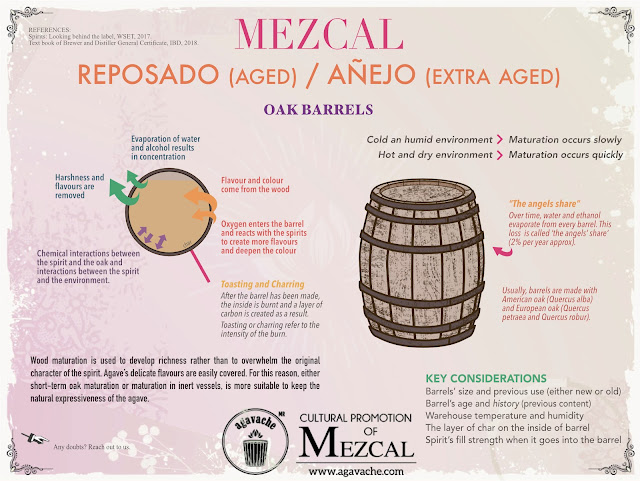Matured Mezcal or Aged Mezcal, which is better?
We @Agavache value the Mezcal’s expressiveness that comes from agave, process, geographical area and producer choices and for this reason, in this post we will explain the differences between maturation in wood and maturation in inert vessels and why we prefer the “natural” Mezcal.
Mexican regulation (NOM 070) defines the classes of Mezcal as follows:
- Madurado en Vidrio (Matured in glass): Mezcal that has been stabilised in glass containers for more than 12 months, either underground or in an area with minimum variations in luminosity, temperature and humidity.
- Añejo (Extra aged): Mezcal that must be aged in wooden containers of guaranteed inoffensiveness (sic) and smaller than 1000 L for more than 12 months in an area with minimum variations of luminosity, temperature and humidity.
- Reposado (Aged): Mezcal that must remain between 2 and 12 months in wooden containers of proven inoffensiveness (sic), without any further restrictions as to size, shape or capacity in litres of the container, but in an area with minimum variations of luminosity, temperature and humidity.
Both Mezcal Reposado and Mezcal Añejo have a maturation process in the wooden barrel. Their differences are the time spent in storage and the capacity restriction of barrels used.
During the maturation, wood adds congeners to the spirit, which are noticed in the colour and aroma changes. Usually, the colourless spirit turns lemon colour and over the time becomes more intense and changes to gold, then amber and finally brown. With regards to the aromas, vanilla (vanillin), coconut (oak lactone) and spices (eugenol) are the most commonly aromas extracted from the wood. At the same time, volatile compounds from the spirit (such as ethanol and acetaldehyde) are lost by evaporation and the char on the inside of the barrel removes sulphur compounds and off-flavours (aldehydes). On top of that, chemical reactions between componentes of the spirit or between components of the spirit and wood, take place and allow acetal formation and esterification.*
The amount of influence that wood can have on a spirit depends on many factors such as the time, warehouse temperature, barrel’s design (size, kind, age and previous content), the level of toasting and the fill strength.
When Mezcal is maturated in glass vessels, there is no change to the colour; it remains colourless as a newly made spirit. In longer ageing, mezcal’s texture becomes smoother and more mouthfilling. Its flavours change too. Neither the glass nor the soil (if the container was buried) releases congeners, Mezcal’s characteristics change because its own components react with each other and esterification takes place.* The spirit develops richness and complexity.
Historically, agave spirits have been drunk “white” or “young”. It is believed that ageing in wood barrels was a practice of the whisky tradition adopted into the tequila industry to make its spirit softer. In 1940, during the agave shortage, tequila producers were buying mezcal from Oaxaca and they requested and encouraged to mature Mezcal in wood barrels.
There are spirits that should have wood maturation, either because it is a tradition or a regulation. Truly, finding the harmony between the raw material and the wood is an art! This post-distilling process can play an active role in determining the appearance, aroma and texture of a spirit. Therefore, distilleries take great care in this practice: highly qualified workers manage the warehouse and ‘blenders’ match up different barrels to get the brand’s insignia blend. Distillers choose the different intensities of toasting, different species of oak, and barrels with different histories (previous uses), in order to launch new “innovative” products.
On the other hand, there are spirits where producers want to express the clarity and purity of them, like Vodka, or where the desire is to celebrate the expressiveness of the raw material over other flavours, like agave spirit’s case. There are more than 40 species of agave that are used to produce mezcal and every one has a wide range of aromas that deserve to be valued on their own. On top of that, agave’s delicate flavours are easily covered by the prevailing wood’s flavours.
The main goal of maturation is enriching the spirit’s sensory qualities, either for creating flavours or for overwhelming the senses. Just as there are spirits that have been developed for their successful evolution in wood, there are spirits whose qualities are more enjoyable without any flavour or colour added.
*Esterification: During maturation the fatty acids and alcohols continue to react with each other to form new esters. Furthermore, some existing esters break apart, adding to the material that can form new esters. The number and type of esters in the matured spirits is very different from those that were in the newly made spirit. However, the amount and nature of the change that can take place is entirely dependent on the quantity and type of fatty acids, alcohols and esters in the spirits as it comes off the still. (WSET, 2019)
References:
Brewing and Distilling General Certificated (text book), Institute of Brewing & Distilling (2017).
Estarrón Mirna, Edith Lopez, Sandra Martín del Campo, Juan Gallardo, Ernesto Ramirez, Ricardo Cosio y Jorge Garcia. Ciencia y Tecnología del Tequila, “Calidad del Tequila: Marco normativo y composición del producto”, CIATEJ, pp 305-309 (2015).
Ridgell, Mark, Spirits Distilled,Infinite Ideas (2016).
Spirits: Looking behind the label, Wine & Spirits Education Trust (2017).
Understanding spirits: explaining style and quality, Wine & Spirits Education Trust (2019).
Norma Oficial Mexicana NOM 070-SCFI-2016 Bebidas alcohólicas-especificaciones Mezcal, Diario Oficial de la Federación. Recuperado de: https://dof.gob.mx/nota_detalle.php?codigo=5472787&fecha=23/02/2017






Comments
Post a Comment